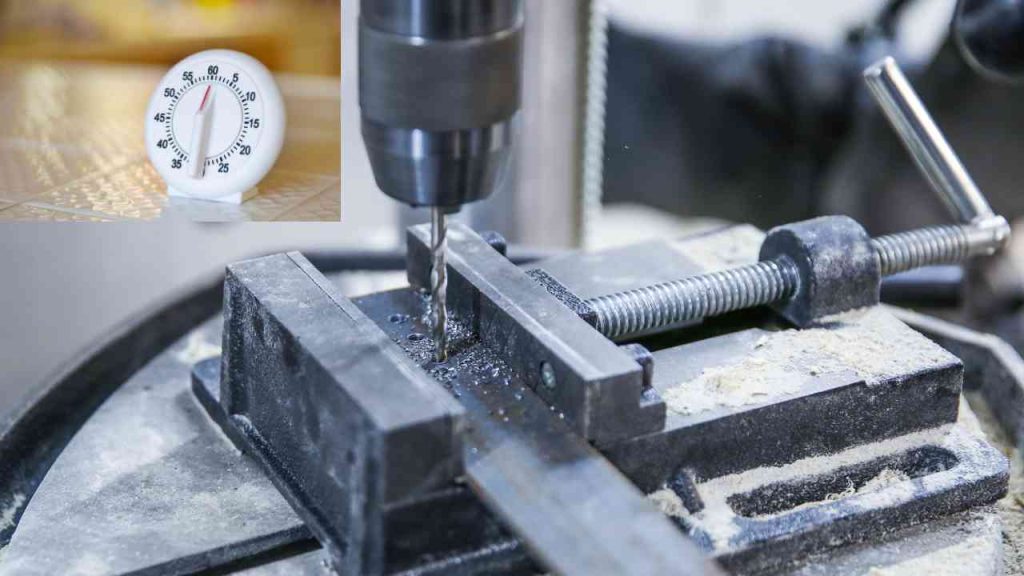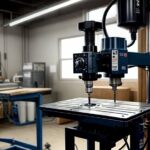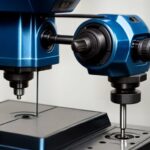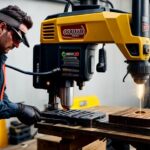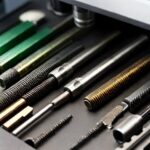Whether you’re a professional carpenter, metalworker, or DIY hobbyist, you need a drill press. This tool enables you to drill exact and consistent holes, making it useful for various tasks. But if your drill press is fixed due to runout, your job will improve substantially in terms of precision and quality.
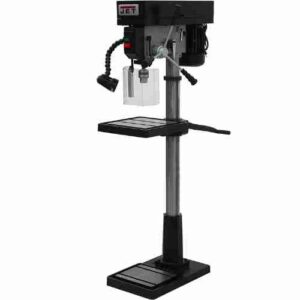 What is drill press runout?
What is drill press runout?
The term “runout” describes the amount by which a spinning component deviates from its intended motion. Runout occurs in a drill press when the chuck or spindle is not correctly aligned, causing the drill bit to sway or veer off course. Due to this, the drilled material may be damaged, and the holes may turn out irregular or too big.
Runout on a drill press may be hazardous and reduce the quality of your job. Drill press injuries may occur if the bit gets misaligned and vibrations reach dangerous levels or if the drill press itself breaks.
Types of drill press runout:
Runout is classified into three types: radial, axial, and total. Each has a distinct impact on the precision and quality of the drilled holes.
- Radial Runout: This is caused by the drill bit wobbling circularly as it revolves. This might cause the hole’s diameter to be greater or smaller than desired, as well as an uneven or tapered hole. Radial runout is caused by spindle, bearing, or chuck difficulties.
- Axial Runout: Axial runout happens when the drill bit spins and travels up and down. This may cause the hole’s depth to change or form a stepped hole. Axial runout is caused by chuck, drill bit, or spindle difficulties.
- Total Runout: Total runout is the sum of radial and axial runout. This happens when the drill bit travels in both circular and up-and-down movements. Total runout may produce a mix of radial and axial runout problems.
What causes drill press runout?
- Worn Bearings: The bearings in the drill press spindle might wear out over time, causing the spindle to wobble or slide as it revolves.
- Misaligned Parts: If the chuck or spindle is misaligned, the drill bit will revolve off-center, resulting in a runout.
- Damaged or bent spindle: A damaged spindle may also cause runout.
- Low Drill Bit Quality: The drill bit’s quality might also lead to runout. When a bit is not correctly balanced or has uneven flutes, it might wobble as it turns.
- Improper Chucking Procedure: Runout might occur if the drill bit is not correctly secured in the chuck.
- Reduced Accuracy: When the drill bit wobbles or slides off-center owing to runout, the holes might become misaligned or not straight, resulting in mistakes.
- Decreased Precision: Runout may cause the diameter of the hole to change or produce an uneven surface, affecting the end product’s accuracy.
- Increased Scrap or Rework: If holes are out of tolerance owing to runout, they may have to be scrapped or reworked, resulting in additional costs and effort.
- Rough Surfaces or Burrs: Runout may result in rough surfaces or burrs, which can be difficult to remove and influence the final product’s quality.
- Higher Tooling Costs: If runout causes the drill bit to wear out quicker, it may lead to higher tooling costs since bits must be changed more often
How to fix drill press runout? 4 Easy Steps
Here are the steps you can follow to troubleshoot and fix the drill press runout:
Step 1: Make sure the chuck and spindle are correctly aligned. To start, check the chuck and spindle for apparent damage or misalignment. Adjusting the chuck or spindle may help runout if you find any difficulties. Replacing the chuck or spindle may be necessary if the misalignment needs to be corrected or if you cannot correct it.
Step 2: Checking for and repairing broken or worn bearings. Look for damage or wear on the bearings next. Fixing the runout problem may need replacing the bearings if broken or worn. If you have the right equipment and knowledge, you might repair this or get it done by a professional.
Step 3: Tighten any loose mounting bolts or bases. Check for loose bolts where the drill press is attached to the base or workbench and tighten as needed. The key to avoiding runout is a solid, safe base.
Step 4: Investigate other explanations and deal with those that apply. If the abovementioned measures do not resolve the runout problem, additional factors might be at play. Issues with the drill bit, the drilled material, or the drill press are all possible causes. Figure out what else needs fixing to correct the runout, then do it.
In a drill press, it isn’t easy to attain perfect alignment and balance; thus, some runout is to be expected. Runout is a normal part of using a drill press, but too much of it might compromise your precision and efficiency, so it’s best to fix it if it’s a problem.
What is an acceptable runout on a drill press?
The allowable degree of runout on a drill press may be determined by several criteria, including the application and kind of drill press employed. Nonetheless, a runout of 0.002 inches or less is acceptable for most drilling applications. Most drilling jobs, including woodworking and metalworking, should be OK with this runout.
Certain applications may need greater precision and hence a lower amount of runout. For example, precision machining or high-precision drilling may need a runout of 0.001 inches or less. In these instances, choosing a high-accuracy drill press and monitoring and correcting for runout frequently is critical.
Preventing future drill press runout:
Drill press runout may be avoided in the future by adhering to certain basic rules for maintaining and operating the tool:
1. Regular maintenance and inspections
The best way to prevent significant problems with your drill press is to do routine maintenance and inspections. Maintenance of a drill press includes checking and tightening mounting nuts to replace broken or worn components and cleaning and lubricating the machine. By keeping up with routine maintenance, you may reduce the likelihood of runout and other problems.
2. Proper usage and handling of the drill press
You may assist in maintaining the drill press’s long life by operating it properly and according to manufacturer recommendations. You may also reduce the risk of runouts and other problems by learning how to properly use and maintain your drill press. As such, it’s essential to avoid overloading or mishandling the drill press and stick to the manufacturer’s guidelines for safe operation and handling.
3. Using high-quality replacement parts
It is crucial to purchase high-quality replacement parts intended to fit and work correctly when it is time to change components on your drill press. Runout and other difficulties might detract from your drill press’s effectiveness if you use cheap or ill-fitting components.
Investing in high-quality replacement parts is a great way to guarantee that your drill press continues to function smoothly and efficiently and reduces the likelihood of future breakdowns.
By properly caring for and operating your drill press, you can reduce the likelihood of runout and other problems, maximizing its helpful life and the quality of your work.
How do you calculate drill press runout?
Drill press runout is calculated by measuring the radial and axial movement of the drill bit. These are the actions to take:
- Attach a dial indicator to the drill press table or chuck, ensuring it is as near to the drill bit as feasible. Check that the indicator plunger is aligned with the center of the drill bit.
- Zero the indication by pushing the plunger until it contacts the drill bit, then reset the indicator to zero.
- Turn on the drill press and manually revolve the spindle to confirm that the dial indication follows the drill bit movement.
- Use the indicator to monitor radial and axial movement at many positions around the circle of the drill bit. Take note of the highest and lowest values.
- To determine radial runout, remove the lowest and highest readings. For example, if the highest measurement is 0.004 inch and the lowest measurement is 0.001 inch, the radial runout is 0.003 inch.
- To determine axial runout, take two measurements on opposing sides of the drill bit and subtract the two. For example, if one measurement is 0.002 inch and the opposite measurement is 0.003 inch, the axial runout is 0.001 inch.
- To compute the total runout, sum the radial and axial runouts.
Preventing runout with regular maintenance:
Frequent maintenance is required to avoid drill press runout and keep the equipment running optimally. These are some of the reasons why frequent maintenance is essential:
- Prevents wear and tear: Drill press components may wear down or get damaged over time, resulting in runout. Frequent maintenance may assist in detecting indicators of wear or damage and addressing the problem before it causes runout.
- Ensures adequate lubrication: Lubrication is essential for effectively operating a drill press. Routine maintenance includes keeping all moving components lubricated to reduce friction and wear.
- Assists in maintaining alignment: Correct alignment of drill press components is critical for avoiding runout. Routine maintenance may assist in ensuring that the spindle, chuck, and drill bit are aligned correctly.
- Extends the machine’s lifetime: Proper maintenance may assist in extending the drill press’s lifespan by reducing wear and damage to components. This may prevent expensive machine maintenance or replacement.
- Increases safety: A badly maintained drill press may be dangerous. Frequent maintenance may assist in identifying and addressing any safety concerns, resulting in a safer working environment.
Frequently Asked Questions (FAQs)
1. How can I tell if my drill press has runout?
You can check for runout by using a dial indicator, which measures the radial and axial movement of the drill bit. Attach the dial indicator to the drill press table or chuck and monitor the movement as you manually rotate the spindle. If there is significant wobble or deviation from the intended path, your drill press may have runout.
2. Is it normal for a drill press to have some runout?
Yes, it is normal for a drill press to have some degree of runout due to the difficulty of achieving perfect alignment and balance. However, excessive runout can compromise the accuracy and efficiency of your work, so it is essential to address any significant runout issues.
3. How often should I perform maintenance on my drill press to prevent runout?
The frequency of maintenance depends on your drill press usage and the manufacturer’s recommendations. Generally, it’s a good idea to perform routine inspections and maintenance at least once every few months, or more often if you use your drill press heavily.
4. Can I fix drill press runout myself, or should I hire a professional?
Fixing drill press runout can often be done by yourself if you have the necessary knowledge and tools. However, if you are unsure about the process or if the issue is more complex, it’s best to consult a professional to prevent further damage to your drill press.
5. How do I know if my drill press bearings are worn out and causing runout?
Worn-out bearings can cause wobbling or sliding in the spindle, leading to runout. To check for worn bearings, inspect them for visible damage or wear, and listen for any unusual noises while operating the drill press. If you suspect that the bearings are worn, it’s best to replace them to prevent further issues.
6. Can using a low-quality drill bit cause runout?
Yes, using a low-quality drill bit can contribute to runout. If a drill bit is not correctly balanced or has uneven flutes, it may wobble as it rotates, causing runout. To prevent this issue, invest in high-quality drill bits that are designed for your specific drilling application.
Final Word:
Keeping your drill press in good working order guarantees your job’s security and accuracy. Runout and other problems may be avoided with careful care and maintenance of the drill press and high-quality replacement components when necessary. Your drill press will serve you well and provide better results across the board if you take the effort to keep it in good working order.
- Where are WEN drill presses made? - April 2, 2023
- Where are Rikon drill presses made? - April 1, 2023
- Where are Powermatic drill presses made? - April 1, 2023

